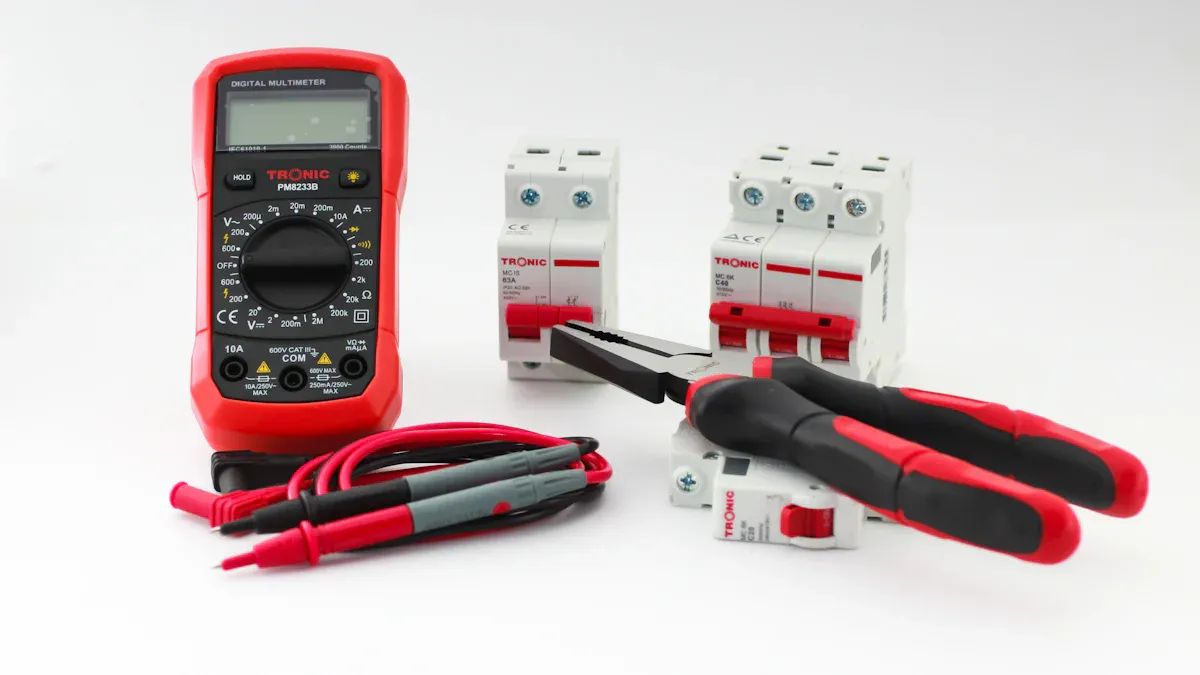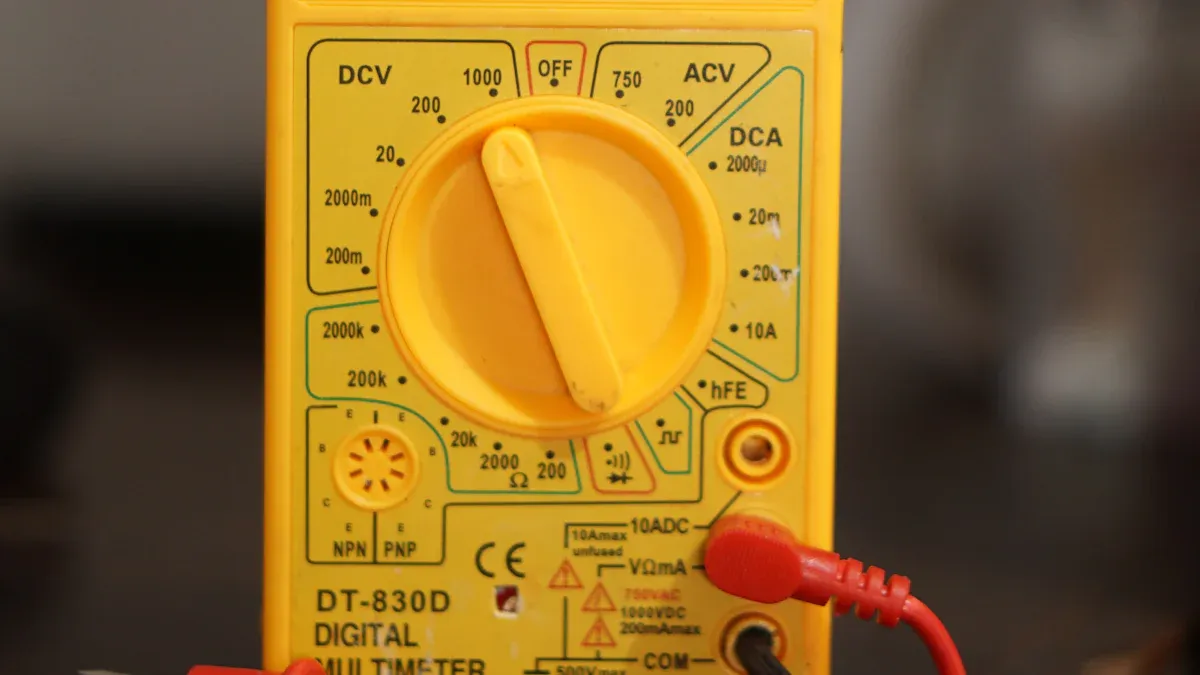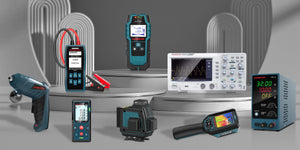
Multimeter vs Oscilloscope Which Tool Should You Use
When you need to check electrical values, understanding the difference between multimeter oscilloscope is important. If you want exact numbers for voltage, current, or resistance, use a multimeter. Multimeters provide accurate readings for signals that do not change. On the other hand, oscilloscopes let you observe how signals change over time, showing shapes and patterns that multimeters cannot detect. The difference between multimeter oscilloscope comes down to what you need to measure. Use this table to compare:
|
Feature |
Multimeter |
Oscilloscope |
|---|---|---|
|
Measurement Type |
Static values |
Dynamic signals |
|
Display |
Numeric |
Graphical waveform |
Key Takeaways
-
Use a multimeter to measure steady electrical values. It gives exact numbers for voltage, current, and resistance.
-
Pick an oscilloscope to watch signals change over time. It helps you find quick problems like spikes or noise.
-
Multimeters show numbers on a screen. They are simple and good for quick checks. Beginners can use them easily.
-
Oscilloscopes show waveforms and patterns. They help with fast or tricky signals. You need to learn more to use them well.
-
Choose your tool based on what you need. Use a multimeter for simple and steady tests. Use an oscilloscope for detailed signal study and fast changes.
Difference Between Multimeter Oscilloscope

Measurement Types
When you look at the difference between multimeter oscilloscope, you see what each tool does. A multimeter gives numbers for voltage, current, and resistance. It can also check if a wire is connected or test diodes. Some multimeters can measure frequency or capacitance too. Multimeters work best with signals that do not change, like checking a battery or a wire.
Oscilloscopes are different. They show how voltage changes over time. You can see waveforms, like sine or square waves, on the screen. This helps you find problems like noise or sudden changes in a signal. Oscilloscopes can measure slow or very fast signals. They can even see signals that change millions of times per second. You can use them to look at sound waves, digital pulses, or radio signals.
Tip: If you want to watch a signal move or change, use an oscilloscope. If you only need a number, use a multimeter.
Here is a quick comparison:
|
Measurement Type |
Multimeter |
Oscilloscope |
|---|---|---|
|
Voltage |
✔️ Direct, accurate |
✔️ Shows changes over time |
|
Current |
✔️ Direct |
✔️ Indirect (needs extra steps) |
|
Resistance |
✔️ Direct |
❌ Not direct |
|
Frequency |
✔️ Some models |
✔️ Most models |
|
Waveform Shape |
❌ Not possible |
✔️ Yes |
|
Transient Events |
❌ Not possible |
✔️ Yes |
Display and Output
The difference between multimeter oscilloscope is also in how they show results. A multimeter gives a number on its screen. For example, you might see "12.00 V" or "0.50 Ω". This is easy to read and good for simple checks.
An oscilloscope gives a graph. The screen shows voltage up and down, and time side to side. You can watch the signal move and change as it happens. This lets you see the shape of a wave, how often it repeats, or if there is noise.
-
Multimeter: Shows numbers, easy to read, best for steady values.
-
Oscilloscope: Shows graphs, best for signals that change.
Note: The graph on an oscilloscope helps you find problems a multimeter cannot show, like a quick spike or missing part of a signal.
Accuracy and Speed
You also see the difference between multimeter oscilloscope in accuracy and speed. Multimeters are very accurate for steady signals. They can measure voltage, current, and resistance with high precision. Most digital multimeters show results with many digits. This makes them great for labs or fixing things.
Oscilloscopes are made for speed. They can measure signals very quickly, even billions of times per second. This lets you see fast changes, like a glitch or a short pulse. But oscilloscopes are not as accurate as multimeters for just one number. They are better for watching how a signal acts over time.
|
Feature |
Multimeter |
Oscilloscope |
|---|---|---|
|
Measurement Speed |
Slow (1-10 times per second) |
Very fast (millions to billions per second) |
|
Accuracy |
High for static values |
Lower for single values, high for timing |
|
Bandwidth |
Low (good for DC, low-frequency AC) |
High (good for fast, complex signals) |
If you need to measure a signal that changes fast, use an oscilloscope. If you need a very exact number for voltage or resistance, use a multimeter.
The difference between multimeter oscilloscope is clear when you pick the right tool for your job. Use a multimeter for simple, steady checks. Use an oscilloscope to see what happens in a circuit over time.
When to Use a Multimeter

Common Uses
A multimeter is used to measure voltage, current, and resistance. You can also check if a circuit is connected. Multimeters help you find wiring problems and test batteries. They show if a fuse is working or not. In irrigation systems, you can check AC or DC voltage and resistance. This helps you find problems like shorts or open circuits. For example, if you test a solenoid and see 20 to 60 ohms, it works well. If the number is much higher or lower, there is a problem. You can also use a multimeter to check diodes or transistors. You do this by measuring resistance or checking if the circuit is complete. If you want to know if a circuit is open or closed, use the continuity setting. The multimeter will beep if the path is complete. Multimeters are good for regular checks and finding exact numbers when signals do not change.
Pros
-
You get accurate numbers for voltage, current, and resistance.
-
It gives steady results, even if the temperature changes.
-
High input impedance keeps sensitive parts safe and results correct.
-
One tool can do many tests in one device.
-
It helps you stay safe by finding live wires or short circuits.
-
You can use it in homes, cars, factories, and solar systems.
-
It is easy to use for quick checks and regular work.
Tip: You save time and money because you only need one tool. A multimeter can do many jobs.
Cons
|
Limitation Aspect |
Explanation |
|---|---|
|
Waveform Dependency |
Multimeters only give correct AC readings for simple sine waves. You need special meters for complex signals. |
|
Frequency Limitations |
Most meters work best at low frequencies. High-frequency signals may not show the right values. |
|
Input Impedance Effects |
Some meters can change the circuit and give wrong results if impedance is too low. |
|
Analog vs Digital Advantages |
Analog meters show changes fast. Digital meters may miss quick changes. |
|
Safety and Measurement Range |
Regular multimeters are not safe for high-voltage or high-frequency signals. You need special probes for those. |
Multimeters are best for signals that do not change fast. If you need to see quick changes or waveforms, use an oscilloscope instead.
When to Use an Oscilloscope
Common Uses
You use an oscilloscope to watch how signals change. This tool helps you find problems that a multimeter cannot show. Oscilloscopes let you see voltage waveforms and spot noise. You can catch quick events like glitches or spikes. You can measure rise time, fall time, pulse width, frequency, and phase angle. Many engineers use oscilloscopes to test and design devices. In cars, you can check fuel injectors and sensors. Scientists use oscilloscopes in labs to study signals. Medical workers use them to watch heartbeats and brain waves. Field technicians use handheld models for fixing things in factories or schools.
-
You can study fast or changing signals.
-
You can look at more than one signal at once.
-
You can use special features like FFT analysis and waveform math.
-
You can catch rare or short signal events that other tools miss.
Tip: If you need to see the shape of a signal or find a quick problem, use an oscilloscope.
Pros
-
You see voltage over time, so it is easy to spot problems.
-
Oscilloscopes show fast or changing signals.
-
You can measure many things at the same time.
-
Built-in tools help you study signals in detail.
-
Digital models save waveforms for later and let you share data.
-
You can use oscilloscopes for fixing, designing, checking quality, and learning.
|
Benefit |
Description |
|---|---|
|
Multi-channel support |
You can see and compare many signals at once |
|
Advanced analysis |
Use FFT, math, and automatic measurements |
|
Real-time feedback |
Watch signals as they happen |
|
Data storage |
Save and look at waveforms later |
Cons
-
Oscilloscopes cost more than multimeters because they have more features.
-
You need to learn how to use the display, which takes time.
-
Some models are big and hard to carry, but some are handheld.
-
You may need special probes for some tests.
-
Oscilloscopes can be confusing for beginners because of many settings.
Note: If you only need simple, steady numbers, a multimeter is easier and cheaper. Use an oscilloscope when you need to see and study signals that change.
Choosing the Right Tool
Quick Checklist
Here is a checklist to help you pick the right tool:
-
Do you need to check steady things like voltage or resistance?
→ Pick a multimeter. -
Do you want to watch a signal change over time?
→ Use an oscilloscope. -
Are you fixing simple circuits or doing easy repairs?
→ A multimeter is usually all you need. -
Do you need to find quick glitches, noise, or tricky waveforms?
→ Try an oscilloscope. -
Is your money tight?
→ Multimeters cost less and work well for most jobs. -
Are you new to this or just learning?
→ Start with a multimeter. Oscilloscopes cost more and are harder to use. -
Do you work with fast electronics or need special tests?
→ An oscilloscope will help you more.
💡 Tip: Oscilloscopes can cost about $67 for simple ones and over $1,100 for fancy ones. Multimeters are cheaper and easier for people just starting out.
Scenario Guide
You might still wonder which tool is best for your project. Here are some common jobs and the best tool for each one:
|
Scenario |
Best Tool |
Why |
|---|---|---|
|
Checking a battery or wall outlet |
Multimeter |
Gives quick, correct voltage numbers |
|
Troubleshooting a car’s sensors |
Oscilloscope |
Shows fast signals and finds problems |
|
Building a simple LED circuit |
Multimeter |
Checks voltage and makes sure wires connect |
|
Repairing a computer power supply |
Both |
Use a multimeter for steady voltages, oscilloscope for noise or ripple |
|
Learning electronics as a hobby |
Multimeter |
Cheap, easy to use, good for beginners |
|
Designing or testing high-speed circuits |
Oscilloscope |
Catches fast changes and tricky waveforms |
You can also check out these popular models for your skill level:
|
User Level |
Recommended Model/Brand |
Key Features |
|---|---|---|
|
Homeowners |
Circuit Specialists CSI2205D |
Good price, does basic electrical work |
|
Hobbyists |
Hantek 2D72 Oscilloscope Multimeter |
Combo tool, 70MHz, USB, rechargeable |
|
Professionals |
FLUKE 87V, KLEINTOOLS MM6000 |
Very accurate, tough, wide range of tests |
If you want to save money and only need simple checks, a multimeter is the best pick. For harder jobs or looking at signals, get an oscilloscope.
Now you know how multimeter and oscilloscope tools are different. Multimeters show exact numbers for voltage, current, and resistance. Oscilloscopes let you watch signals move and change over time. They help you find problems in tricky systems. Use a multimeter when you want steady and correct numbers. Choose an oscilloscope if you need to look at waveforms or catch quick changes in signals. Always pick the right tool for what you need to measure so you get the best results.
FAQ
Can you use a multimeter instead of an oscilloscope?
A multimeter cannot show waveforms or fast changes. It only gives you numbers. An oscilloscope lets you see how signals move and change.
Tip: Use a multimeter for steady values. Use an oscilloscope for changing signals.
What signals can an oscilloscope measure?
Oscilloscopes can measure AC and DC signals. They also measure sound waves, digital pulses, and radio signals. You can see quick spikes, glitches, and noise with them.
-
AC voltage
-
DC voltage
-
Audio signals
-
Digital signals
Why does a multimeter cost less than an oscilloscope?
A multimeter has simple parts and measures basic things. An oscilloscope has more advanced electronics. It can show waveforms and fast changes. This is why oscilloscopes cost more.
|
Tool |
Price Range |
|---|---|
|
Multimeter |
$15 – $200 |
|
Oscilloscope |
$67 – $1,100+ |
Do you need special training to use an oscilloscope?
You do not need a degree to use one. You should learn how to set up the display and use the probes. Many people watch videos or read guides to learn.
Note: Practice helps you use an oscilloscope with confidence.




Dejar un comentario